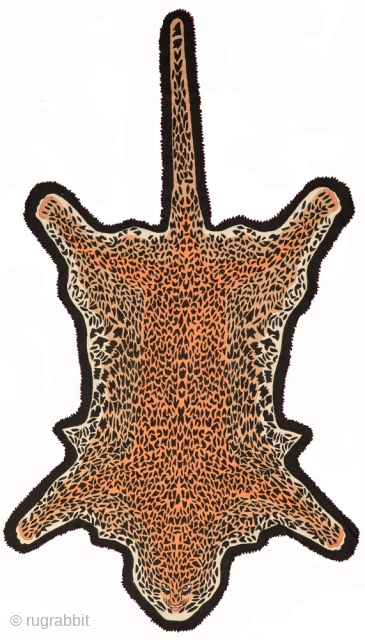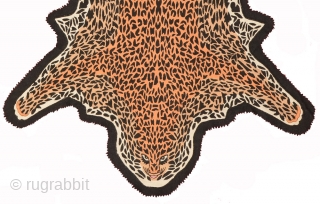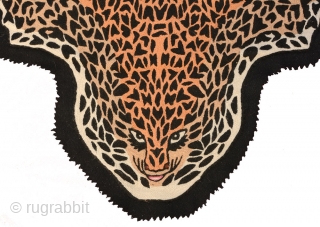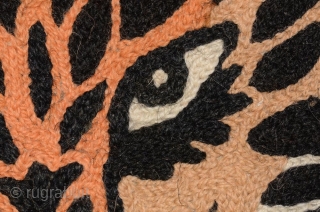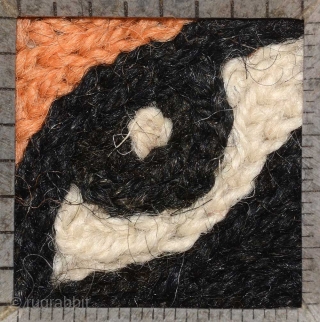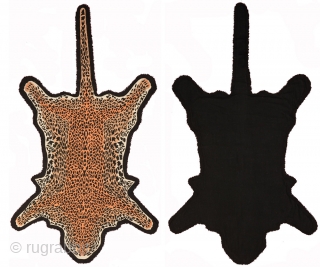Back
Look out! Snow Leopard! Vintage wool-embroidered soft and supple snow leopard 'pelt' bought from a Tibetan shopkeeper in Ladakh, but almost certainly woven in Kashmir in the 2nd half of the 1900’s. Mix of dyed and undyed fine wool chain-stitched (see * below) embroidery backed by a layer of medium-thickness black felt. The super-fine wool used for the embroidery purportedly comes from Tibetan sheep farmed in the highland region of Ladakh or Zanskar, a region to the north and west of Kashmir once primarily inhabited by people of Tibetan stock. To get an idea of how fine the wool is, and the tightness of the weave, the close-up ‘framed’ photo shows just one square inch around one of the leopard’s eyes. The size is 215cm long, x 121cm wide at front legs, x 70cm wide across stomach (approximately 84.5in x 47.5in x 27.5in). In very good condition and somewhat ‘rare’, as the Kashmiri's usually wove embroideries like this as tiger pelts (see https://warpandweft.club/portfolio-item/kashmir-item-1/ ), and some auction houses often sell them – when they arise rarely on the market - as coming ‘from Tibet’, when these weaving's simply do not. (*The use of the chain-stitch is an ancient craft; examples of surviving Chinese chain-stitch embroidery worked in silk thread have been dated to the 5th – 3rd century bc. It is a sewing and embroidery technique in which a series of looped stitches form a chain-like pattern.) Please see more photos and information here; https://warpandweft.club/portfolio-item/kashmir-item-2/
price:
POR. wandw@nym.hush.com
- Home
- Antique Rugs by Region
- Category
- Profiles
- Post Items Free
- Albums
- Benaki Museum of Islamic Art
- Budapest: Ottoman Carpets
- Gulbenkian Museum
- Islamic Carpets. Brooklyn
- Islamic Textiles. Brooklyn
- Konya Museum: Rugs
- MKG, Hamburg
- MMA: Caucasian Carpets
- MMA: Mamluk Carpets
- MMA: Mughal Indian Carpets
- MMA: Ottoman Carpets
- MMA: Safavid Persian Carpets
- MMA: Turkmen Rugs
- McCoy Jones Kilims
- Ottoman textiles. Met
- Philadelphia Museum
- Rugs and Carpets: Berlin
- Seljuqs at the Met
- TIEM, Istanbul: Carpets
- V&A: Classical Carpets
- Vakiflar Carpets: Istanbul
- Baluch Rugs: Indianapolis
- Gallery Exhibitions
- Jaf an Exhibition
- Alberto Levi Gallery
- Andean Textile
- Christie's London: 2016
- Francesca Galloway
- HALI at 40
- ICOC Washington, DC 2018
- Jajims of the Shahsavan
- London Islamic Week April, 2018
- Mongolian Felts
- Navajo Rugs: JB Moore
- Persian Piled Weavings
- SF Tribal & Textile Art Show 2020
- SF Tribal 2019
- Sotheby's: C. Alexander
- Turkish Prayer Rugs
- Turkmen Main Carpets ICOC 2007







